41st Italian Grand Prix

Clay Regazonni was victorious for Ferrari on a sad weekend for F1, after Jochen Rindt lost his life qualifying
Motorsport Images
Regazzoni saves the day
Monza, Italy, September 6th.
After the sweeping victory in Austria the whole of Italy was behind Ferrari for the Italian Grand Prix, to be held over 68 laps of the Monza road circuit, and even on the day before official practice began there were enough spectators, to watch the testing that was going on, to keep a lot of race organisers happy. Ferrari had done all their pre-race testing the previous week, during which Giunti had had a nasty moment when a tyre deflated at full speed through the Ascari curve on the back of the circuit. Although the car was damaged it was mended in time for the official practice on the Friday before the race, so that the vast crowd that turned out to watch on the Thursday before race day had to be content with the BRM team, the new Tyrrell car, the Matra team and the BelIasi, with Stewart having to go in a works Matra-Simca V12. There were 28 entries on the official list and as the Italians are not party to the Geneva Agreement which guarantees 10 entries for named drivers, their accepted 20 cars for the Monza grid was to be the fastest 20 irrespective of name or stature; if you were fast enough you were in, if not you were out, World Champion or no World Champion. The Tyrrell Racing Organisation had entered Stewart in a March, entry number 18, and the new Tyrrell car, entry number 16, so that there were in fact 27 entries vying for the 20 places, and with the grid being a two-by-two affair, instead of the more usual three-two-three arrangement, battles for both ends of the grid could be expected to enliven practice.
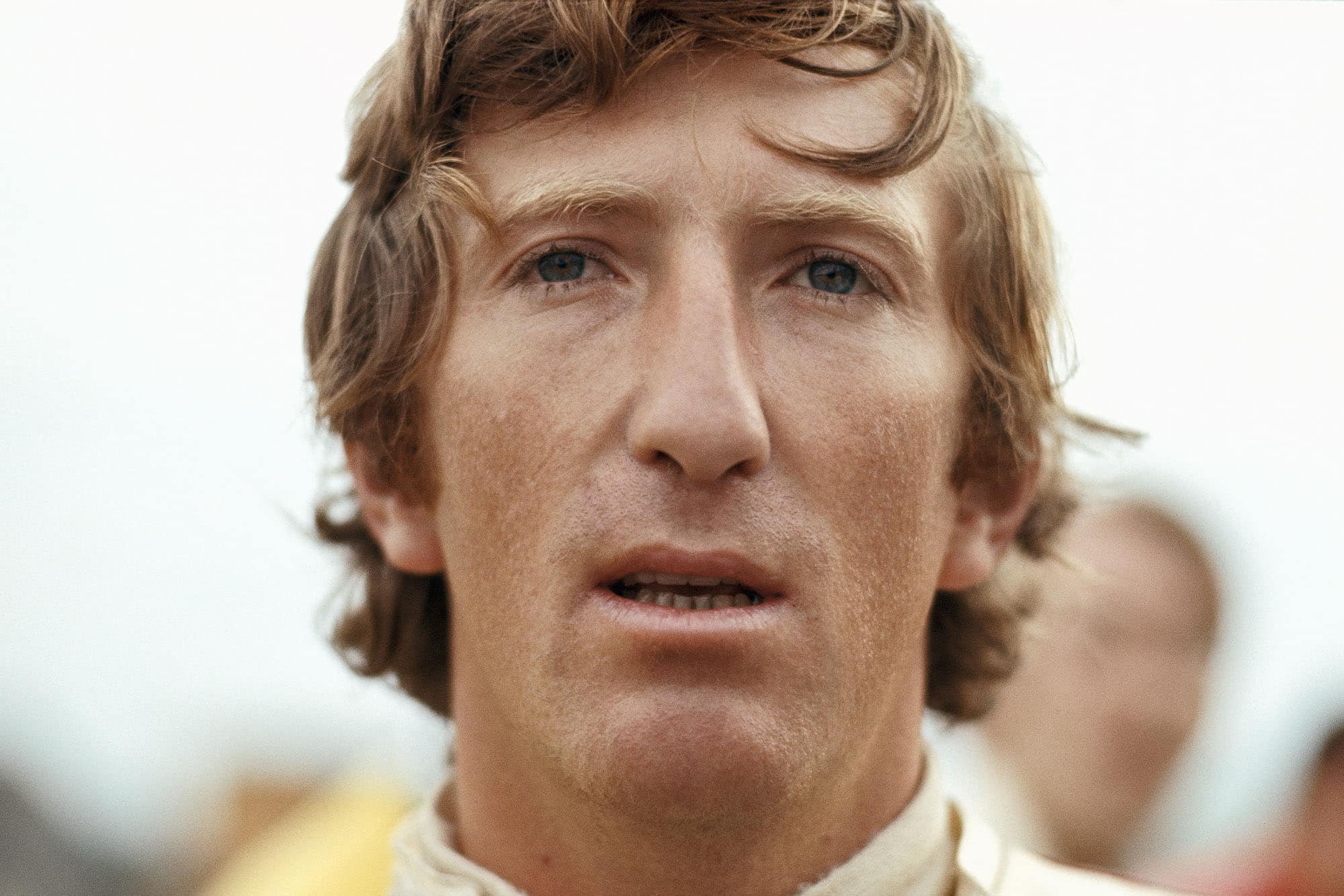
Jochen Rindt was tragically killed in qualifying
Motorsport Images
After the Austrian race the general feeling was that the Ferrari team would set the pace and everyone else would try to hang on to the “tow” provided by their slipstream. Matra even announced that they were prepared to let Beltoise and Pescarolo go 500 r.p.m. over the limit in order to benefit from any slipstreaming, though they did not say “to keep up with the Ferraris”. There was an additional feeling that Enzo Ferrari would run four cars and a certain amount of relief when it was known that Andretti was tied-up in America with USAC racing and “Nanni” Galli was having a second McLaren-Alfa Romeo to support de Adamich. As practice got under way on Friday afternoon, due to run from 3 p.m. to 6.30 p.m., with a one-hour break in the middle, one of the largest concentrations of first-time Grand Prix cars was assembled in the paddock. Ferrari had his four cars, two for Ickx and the others for Regazzoni and Giunti, these being 001, 003, 004 and 002, respectively, while the Yardley-BRM team also had four cars for their three drivers, two for Rodriguez and the others for Oliver and Eaton, being 153/06 with the new V12 engine with improved cylinder heads, and 153/05 for the team leader and 153/04 and 153/03, respectively, for the others. Surtees had two of his own cars to experiment with, TS7/001, the successful Gold Cup winner, and TS7/002, a brand new car, differing only in details such as shock absorbers, rear suspension geometry and material specifications. Stewart had the choice of the new Tyrrell car or his usual March 701/4 and Cevert had March 701/7 as usual, and Gold Leaf Team Lotus had three Lotus 72 models, all to the latest specification, Rindt and Miles in their usual cars, and Fittipaldi in R5, a brand new one. Supporting the works trio of Lotus 72 cars was Hill with R4, the Brooke Bond Oxo Lotus 72 that made its debut at Oulton Park in August. The McLaren team had arrived with just about everything they possessed, the two Cosworth-powered cars M14A/2 and M14A/1 for Hulme and Gethin, the Alfa Romeo-powered M14D/1 for de Adamich and the old M7D/1 resurrected with another Alfa Romeo engine for Galli. The Matra team, the March team and the Brabham team were unchanged from the Austrian race, the pairs of drivers and pairs of cars being as then. To complete the entry were Schenken with the works De Tomaso, Peterson with Crabbe’s March, Moser with his Bellasi and Bonnier with the ex-Surtees McLaren Cosworth M7C/1, though the last entry missed the first day of practice. The weather was superb and as everyone anticipated it was the Ferrari team that set the pace, with Ickx well below the existing lap record of 1 min. 25.2 sec, set last year by Beltoise with an MS80 Matra. However, the true standard was the 1 min. 24:8 sec. set up by Elford with the first of the 5-litre Porsche 917 sports cars back last April, and in the first practice period Ickx was the only one to improve on this, with 1 min. 24.61 sec. Matra were experimenting with extra fuel tanks mounted on the ledges on each side of the cockpit on their cars, to try and solve the problem that lost them third place in the Austrian Grand Prix, and the Brabhams had air boxes, with forward-facing intakes, on the top of the intakes of their Cosworth engines, that looked remarkably like those on the Lotus 72. In an effort to keep pace with the Ferraris most people were removing nose fins and rear aerofoils, to reduce air drag and gain speed on the straights even if it did make the cars a little bit twitchy under braking and rather “nervous” on the corners. The Ferraris were rather rubbing in their power superiority by running in full aerodynamic trim, as raced all season, while Stewart’s March and even Rindt’s Lotus 72 were stripped off and looking very unfinished and strange. The new Tyrrell car was missing for the first part of Friday afternoon, but appeared after the hour break, and had not gone far before it died and Stewart came running back to the pits to continue practice with the March. The spare BRM with the new engine had the wrong gear ratios to begin with and these were changed during the interval and Rodriguez was soon out when practice resumed, but he showed a preference for his old car. Fittipaldi was out in the third of the works Lotus 72 models for the first time and while still learning his way along in it he got involved with a bunch of more experienced drivers and tried to stay with them on braking for the South Curve and lost control, going straight on into the bank, escaping unhurt but damaging the Lotus beyond immediate repair.
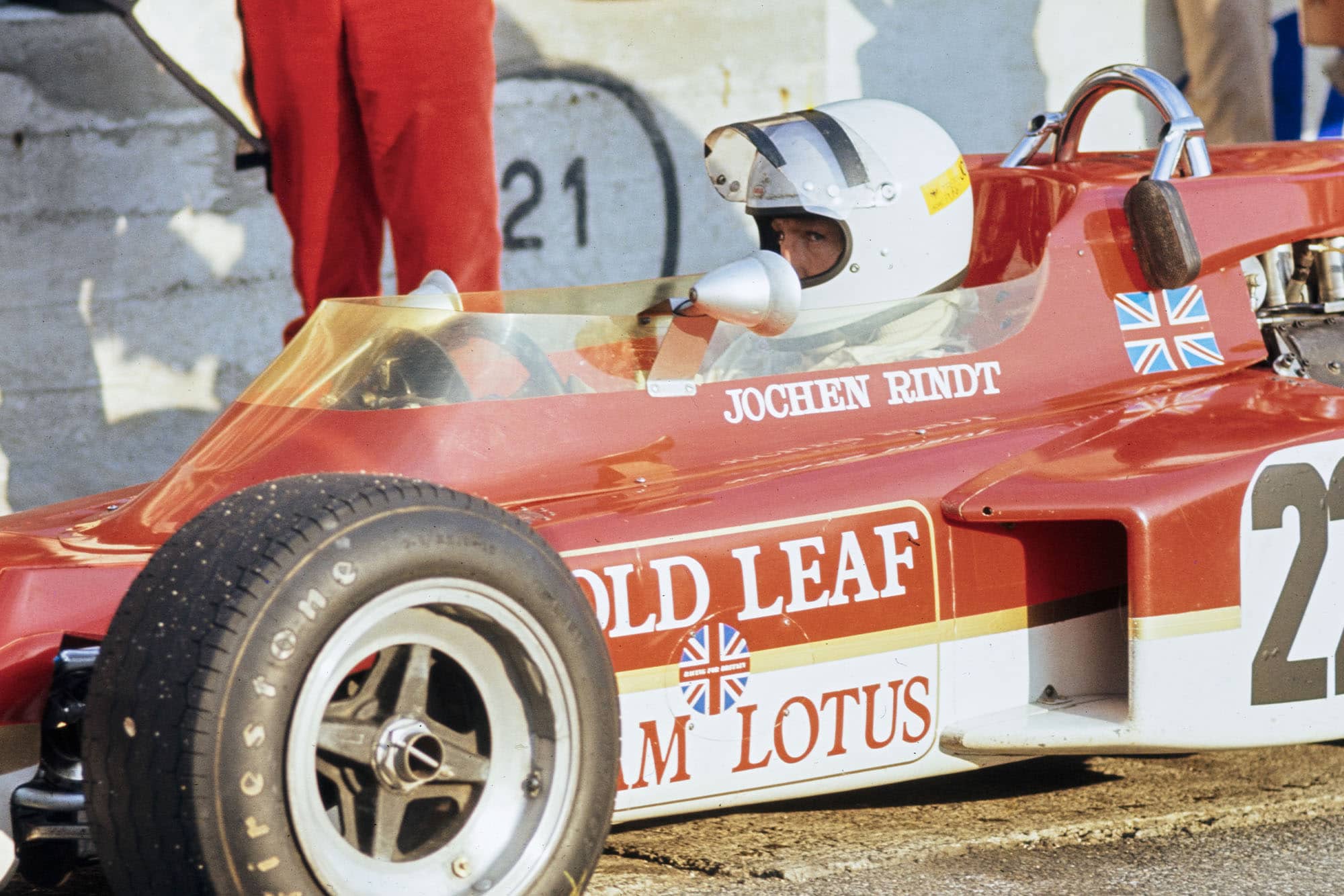
Rindt prepares to leave the pits
Motorsport Images
The Ferrari team continued to dominate the scene, both Regazzoni and Giunti joining Ickx with laps below the existing GP record and the outright record, while Ickx got down to an all-time fastest of 1 min. 24.14 sec. It was rather reminiscent of 1961 when Ferrari had his 1-1/2-litre V6-engined cars and the rest were struggling with obsolete Coventry-Climax-powered machinery, with drivers lurking around the circuit waiting for a passing Ferrari to give them a “tow” in its slipstream. In the first part of the afternoon lckx had used 312B/003 and for the second part he used 312B/001, which seemed to have a better engine. At one point during the latter part of the afternoon two of the BRMs were circulating in close company, one in the slipstream of the other, when Ickx passed them both along the pits straight, crossing through the slipstream as he did so, in order to be placed nicely for the entry to the Curva Grande ! It was significant that the only driver to be in with the Ferraris at the end of the day was Stewart, with the Tyrrell-March 701/4, no one else even looking like getting below 1 min. 25 sec., and only Rodriguez being near the GP lap record. Unaided by Ferrari “aspiration” Stewart had done I min. 24.75 sec., which put him in third place between Regazzoni and Giunti, and this caused the people who think that driving ability does not enter into it at Monza to say that Stewart had a special Cosworth engine. Those who think that all Cosworth engines are equal gave Stewart credit, while the ability of the March 701 was left unsaid to avoid embarrassment to the works STP-March cars and the new Tyrrell car. On Saturday, still in superb weather, practice ran non-stop from 3 p.m. until 6.30 p.m. and it was to be everyone’s last chance to be in the fastest 20 and for the fast ones to try and get amongst the Ferraris. The Tyrrell-Cosworth had been abandoned as there was something radically wrong with the fuel system design, the main tanks not feeding into the collector tank fast enough, and this could not be modified on the spot. Bonnier actually produced the ex-Surtees McLaren M7C and set out to justify his position as a Grand Prix driver, while Surtees was busy comparing his two new cars and looking quite satisfied, that is until near the end of practice when a rear suspension lug pulled away from its mounting on the sub-frame under the gearbox on the first car. The works McLarens had removed the rear aerofoils and mounted in their place the two small fins from the nose, fixed to a crossbar, while Stewart had his March still shorn of its aerodynamic aids and Peterson’s March had had the nose fins actually sawn off. Rindt’s Lotus 72 appeared devoid of aerodynamic aids and with the air ducts leading to the front brakes covered up, but he was not keen on this idea so Chapman agreed to remove the covers. Matra had settled for two types of fuel system, Pescarolo’s car having the extra external tanks and Beltoise not having them. As it was very hot there was not a great deal of activity, the Ferrari team more or less resting on the Friday results, while others were experimenting and preparing for the cool of the evening and the last-minute battle for both ends of the grid. Suddenly the pit area was conscious of an air of quiet descending and a complete lack of activity, and news arrived that Rindt had crashed badly on braking for the South Curve while in close company with Hulme. As always happens on these occasions, the rumour-mongers were soon spreading stories, but it was ominous that Team Lotus packed up and disappeared into the paddock, to be followed by the Rob Walker team with their new Lotus 72, and eventually confirmation came through that Rindt had been killed in the accident. Hulme reported that he had seen the Lotus swerve about under the heavy braking from 190mph and then turn sharp left into the guard rail amidst a cloud of dust, a wheel broken off by the impact coming out of the dust cloud and bounding across the road in front of him.
Practice stopped completely while the wreckage of the Lotus 72 was brought in by a breakdown lorry and impounded in the paddock and the resumption of practice was very lethargic and without enthusiasm. Eventually things got going again, but without any of the Lotus entries, and Stewart went out in his March and put in a cracking 1 min. 24.73 sec. unaided by any faster cars. The afternoon seemed to drag on interminably but just before 6.30 p.m. there was a mad rush and all the fast cars were out in a bunch, during which time Rodriguez and Oliver got down into the select group who had times under 1 min. 25 sec., the Mexican making fastest time of the day at 1 min. 24.36 sec., using the older of his two cars. The death of Rindt in such suspect circumstances took all the fire out of the meeting and whereas practice should have ended on a high note of enthusiasm and anticipation for the race, it was quite the reverse.
Race
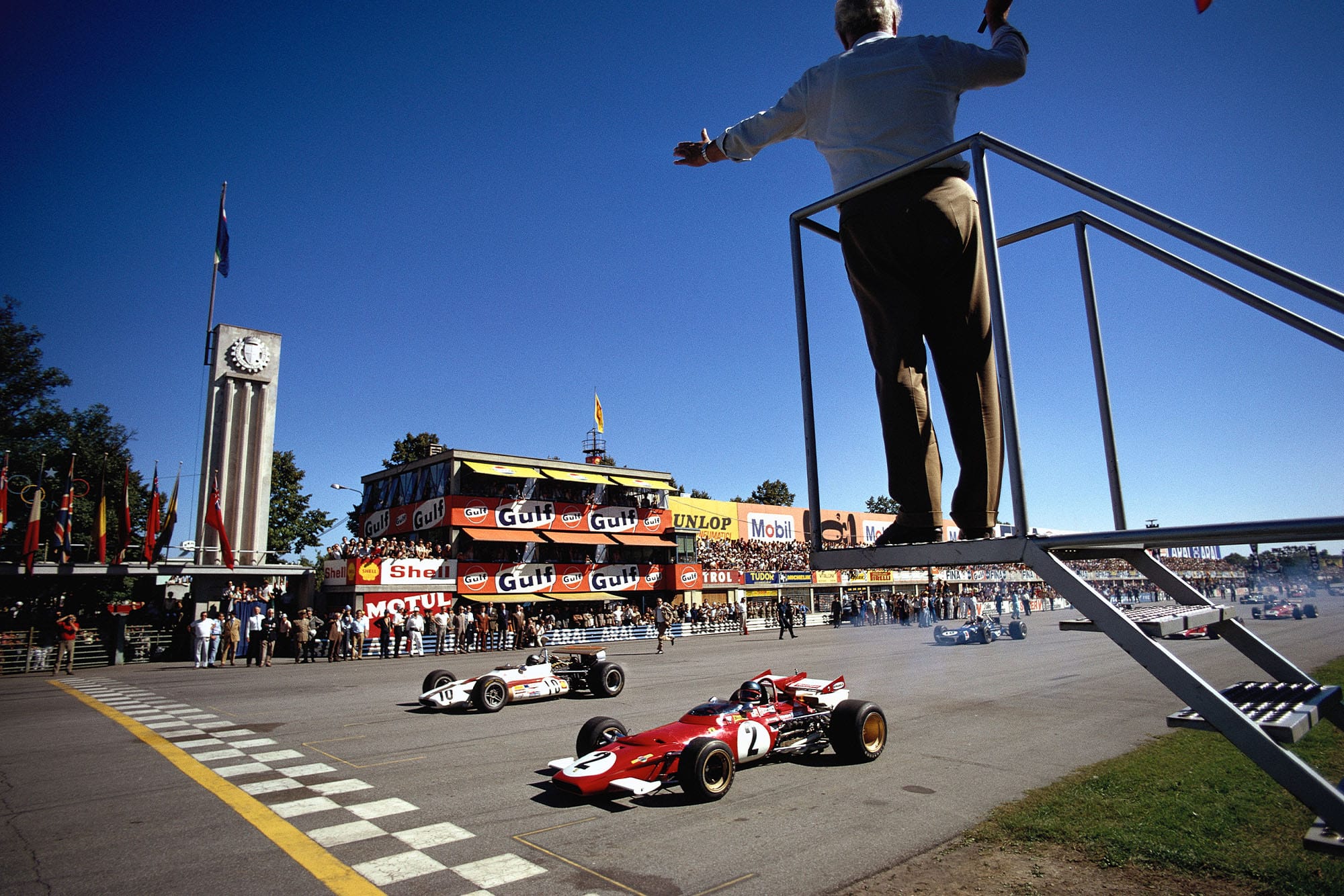
The cars line up on the grid
Motorsport Images
Sunday morning saw the start of a brilliant day, with cloudless skies and a scorching sun and a record crowd had filled the Monza Autodrorno by midday, even though the Grand Prix was not due to start until 3.30 p.m. The Ferrari team had all four cars prepared for the race, with the number 2 for Ickx on 312B/001 and 312B/003, his choice finally falling on 001, while Regazzoni had 004 and Giunti 002. In the BRM team Rodriguez had elected to take the older of his two cars, so the new engine was installed in Eaton’s car in order that it should have some race testing. Matras had not been too impressed with their practice performances so had installed rebuilt engines in both cars and the Surtees team had finished a major rebuild combining the front half of the original car and the rear half of the second car, to replace the damaged rear suspension. With the different geometry of 002 couped to 001 the handling was going to be an unknown quantity, but the only thing to do was to race it and try it. All the four Lotus 72 cars had gone, two of the works cars and the Walker car being on their way home and the remains of Rindt’s car being locked away in a garage. This withdrawal of four top-line cars meant that there would only be three non-starters, and these were Bonnier, Galli and Moser, but the GPDA President was sadly affected by the death of his Geneva neighbour and did not bother to wait, even though he was first reserve should anyone not start. This put “Nanni” Galli as first reserve and the McLaren team prepared the McLaren-Alfa Romeo and took it out to the pits with the other cars. One by one the competitors went off on a warming-up lap and then took their places on the “dummy grid” and it was seen that Surtees was missing, so Galli was sent off on a warm-up lap as the replacement, but before he completed the lap the Surtees TS7 appeared, having been delayed by a leaking fuel bag and in consequence having to have two of them changed. Poor Galli did his warm-up lap, happy in thought of being able to start in his own Grand Prix, only to be directed back into the paddock.
Lined up in pairs the 20 cars made an impressive sight, with the three Ferraris one behind the other on the left and a BRM, the Tyrrell March 701 and another BRM on the right, only Stewart being among the 12-cylindered cars with a V8. As lckx and Rodriguez moved up towards the starting line, followed by the rest, Surtees was sitting with his arm raised, unable to start his engine because of a flat battery. Before the start Stewart had lost all enthusiasm for the race, affected like Bonnier by the death of his close friend and neighbour, but once on the starting grid the “racer” in him overcame his personal emotions and as the flag fell he was right in amongst the Ferraris and BRMs as they screamed away towards the Curva Grande, leaving the unfortunate Surtees to be pushed into the pit lane to have another battery fitted. The clamour from the public left no doubt as to who was leading at the end of the opening lap, and lckx had Rodriguez (BRM), Stewart (March), Regazzoni (Ferrari), Giunti (Ferrari), Oliver (BRM), Siffert (March), Brabham and the two Matras in a string behind him. Next time round Regazzoni had moved ahead of Stewart and as the cars streamed by Siffert raised his arm as his Cosworth engine went “bang” in a big way and he coasted towards thr Curva Grande with the rest of the field dodging by on each side. In the pit lane Surtees got his engine started and joined in to a great round of applause from the enthusiastic spectators, but he only did one lap and went straight into the pits to retire as the car was far from being right. With the race in only the third of its 68 laps and the two cars out of the 20 gone already, it looked like Monza was once more going to sort out the strongest and fittest. On lap 4 there was a great cheer from the British contingent, and a lot of Italians as well, as Rodriguez got his Yardley-BRM into the lead and next lap saw Stewart leading with the Ferraris in third, fourth and sixth places It was all going wrong according to the form book, for a Ferrari 1-2-3 procession had been anticipated, with the others trying to keep pace. From the back of the grid Stommelen had made a superb start and was galloping up through the slower cars, being at the end of the leading bunch on lap 5 and about to pass Brabham, whose engine was misbehaving. Stewart still led on lap 6, with Rodriguez right behind him, and they had Regazzoni in their draught, the Swiss having put aside team orders when he saw Ickx lose the lead.
Usually the field at Monza breaks itself up into groups of varying speeds, but this time there was one big group going by in line-ahead formation almost without a break, from Rodriguez (back in the lead on lap 7) to Brabham in 12th place, with Gethin (McLaren), Eaton (BRM), Peterson (March), Schenken (De Tomaso), Amon (March), and de Adamich (McLaren-Alfa Romeo) straggling along at the rear. Rodriguez had two laps as leader and then it was Stewart’s turn for a lap and then Regazzoni went ahead for a lap. Having weighed up the situation and realised he could not get away from the rest, Ickx was content to sit back a bit and let the race take its inevitable mechanical toll, as he does not enjoy the Monza type of wheel-to-wheel racing, whereas Regazzoni, Rodriguez and Stewart were happy to fight it out every inch of the way, the three of them taking turns in the lead. On lap 12 Regazzoni was in front again, but Ferrari hopes of complete domination had gone, for Ickk was down in seventh place and Giunti was in the pits with a misfiring engine. Next lap a white and gold BRM appeared in the lead, but it was not Rodriguez, it was Oliver having jumped up front third place, and the BRM team leader was missing. After they had all gone by the missing BRM was seen coasting into the pits, trailing oil from a big hole in the side of the engine and with a flat rear tyre, probably punctured due to running over some of the bits that came out of the side of the engine. Stewart was not amused to see Oliver out in front and took the lead on laps 14, 15, 16 and 17, at which point there was a share-out of some of the prize money, as there was to be on laps 34 and 51. Having won himself 590,000 lire for being first across the line on lap 17, Stewart dropped back to third place and let Oliver lead from Regazzoni. The race average was very nearly 234 k.p.h. and rising all the time as no-one was easing up, and Ickx now moved up to review the situation, taking the lead on laps 19 and 20, followed by Oliver, Regazzoni, Stewart, Stommelen and Hulme. Still keeping pace with the leaders were Cevert (March 701/7) and Beltoise, but the other Matra had fallen by the wayside with a sick engine, thought to be valve or valve-spring trouble. From the back of the field the De Tomaso disappeared and Schenken came walking back to the pits to report a blown-up engine and Giunti had gone out after struggling to get his Ferrari engine to run properly. The pace was certainly telling and at 20 laps six cars had fallen by the wayside, while Brabharn’s engine was not well, nor was de Adamich’s Alfa Romeo engine. On lap 21 Oliver was back in the lead and he held it for five laps, with Stewart and Regazzoni changing places behind him, which was some consolation for the Yardley-BRM team for Eaton had to give up due to losing all the water from his BRM cooling system due to porous heads on the new engine. While in the lead Oliver enjoyed being able to drive through the known patches of cement dust and throw it back at Stewart and Regazzoni, as they had been doing to him when he was behind them; all in good-natured sporting fun, of course. Ickx was back in sixth place and keeping to one side of the nose-to-tail scrapping, and on lap 26 he coasted into the pits with his clutch having disintegrated so that the whole of Italy’s hopes now rested on Regazzoni, who was sitting in fourth place, for Hulme had decided he ought to see what it was like up front. On lap 27 Oliver and Stewart were side-by-side, with the orange McLaren behind them. Next lap it was between them and on lap 29 it was leading, but only briefly for next time round it was back in third place, with Oliver leading once more. Stommelen was holding a steady fifth place, well in the draught of the ever-changing lead, and Cevert and Beltoise were keeping up, with Brabham there providing his engine did not play up. Amon, Peterson and Gethin were bringing up the rear, apart from de Adamich who had lost a lot of time at the pits. With the next monetary share-out due at lap 34 Regazzoni moved up and took the lead on lap 32, holding it until lap 35 when Stewart virtually deadheated with him. As the Ferrari took the lead there was a great commotion down at the South Curve for Brabham’s engine had decided to cut out completely and then cut in again at a most inopportune moment and the Australian went sailing off the track, ripping off both left wheels and damaging the monocoque on the barrier. He was quite unhurt and two laps later could be seen walking back to the pits. Stewart and Regazzoni finished lap 35 wheel-to-wheel, With Hulme and Oliver behind them, and at the tail of the runners Peterson’s Cosworth engine broke as he passed the pits and he coasted to a stop on the left of the main straight. He had barely got out of the car when the leaders reappeared, with Regazzoni in the last remaining Ferrari in the lead, and Oliver crossed the line in sixth place with his arm raised as his BRM engine had overheated. He coasted off to the right and stopped opposite the Antique Automobiles’ stricken March, receiving a loud and appreciative ovation as he left the BRM and walked back to the pits. It was certainly proving to be a case of the survival of the fittest, with all three BRMs gone, two Ferraris, one Matra and three Cosworth engines broken.
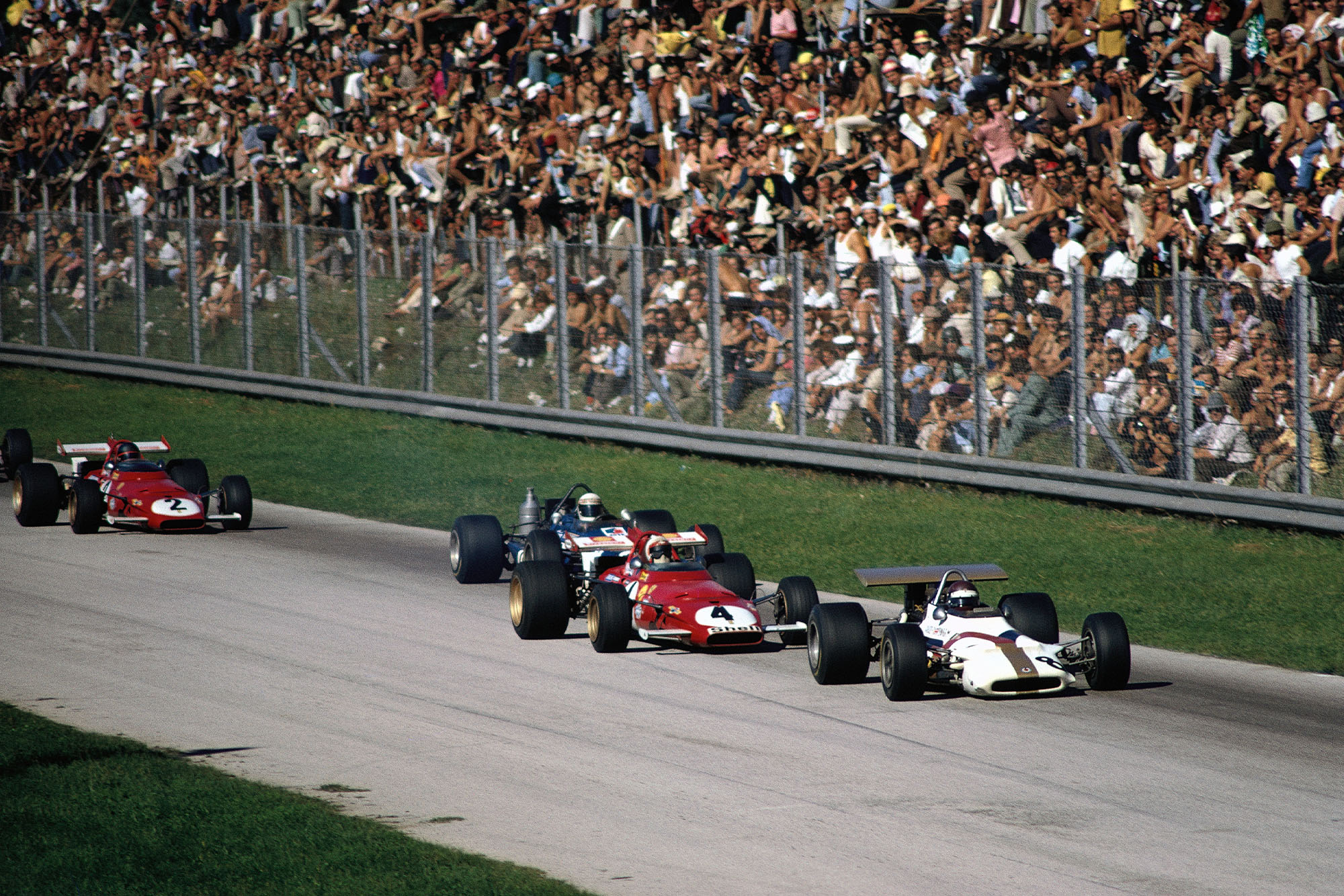
Jackie Oliver leads Clay Regazzoni, Jackie Stewart and Jacky Ickx
Motorsport Images
Beltoise in the screaming Matra now began to move up, passing Stommelen, and as Cevert had been using his compatriot for a “tow” it meant that he lost touch with the leading group, and once out of the suction of the cars ahead he rapidly fell hack. The scene became almost settled for a few laps, with Regazzoni leading Stewart, Beltoise, Hulme and Stommelen in line-ahead formation, sometimes up the main straight on the left, sometimes up the middle, and on one lap right over against the pits wall. The average speed had crept up to 235 k.p.h., hut the track was slippery in places, which prevented any new !ap records being set up, and in fact the race was being run at an almost identical pace to last year. It now became clear that Regazzoni was setting the pace and he led from lap 44 to lap 50, dodging from one side of the track to the other on occasions to weigh up what those behind could do. As it was Stewart in his wake he could not shake him off as easily as that, and Beltoise, Hulme and Stommelen were right in his tyre tracks, but Cevert was now way back and a very lonely Amon was almost in sight of being lapped. Gethin and de Adamich were still running, but had been delayed by pit stops. On lap 51 Stewart snatched a brief lead, and collected another 590,000 lire and next time round Regazzoni had a practice run at coming up in the slipstream of the blue March and “jumping” it as they crossed the timing line, judging it to a nicety. He had another go on the next lap and misjudged it by inches, but he had obviously got the March weighed up. Beltoise now got into second place and on lap 55 Regazzoni let the Matra take the lead and did another practice “slipstream jump” as they crossed the line, but as it was all at a lap time of 1 min. 28 sec. it looked as though he was merely playing with the opposition. Sure enough he then put in two laps at 1 min. 26.2 sec., followed by a run at 1 min. 25.8 sec. and motored away in what must have been a demoralising manner to Stewart, Beltoise, Hulme and Stommelen. At 60 laps it was all over, the Ferrari pulled away at half a second a lap, leaving the others floundering in its wake. On lap 65 Regazzoni recorded the fastest lap of the race, in 1 min. 25.2 sec., equal to the Formula One lap record, and on lap 66 he lapped Amon’s March. As he started his last lap way out on his own, more than 100,000 Italians held their breath in case the Ferrari should break, but as he appeared from the South Curve, able to coast to victory even if the engine had fallen out, pandemonium broke loose and Monza seemed to explode, so that few people saw Stewart, Beltoise and Hulme racing for the finish to claim second place, the decision going to the March by seven hundredths of a second. The whole finishing straight disappeared under a seething mass of Italian and Swiss spectators, 12-ft.-high wire fences being no barrier to a Ferrari enthusiast, and Ferrari flags, Swiss flags and Italian flags flew from the multitudes like banners in a medieval battle. As Cevert came out of the South Curve, heading for the finish and a worthy sixth place he was confronted by a sea of cheering, waving, running humanity and had to cross the line at a walking pace.
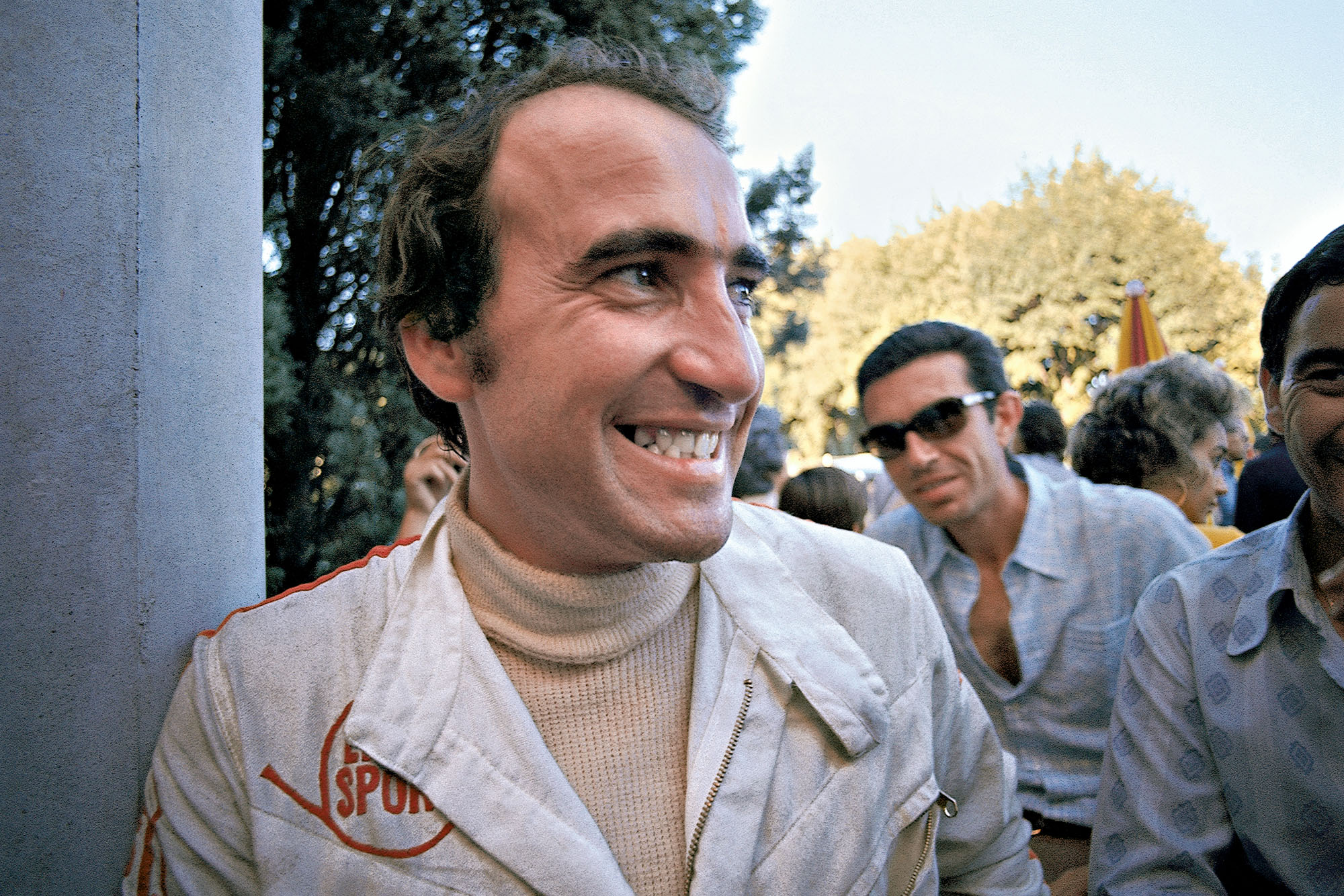
Regazzoni shows his delight at winning.
Motorsport Images
We thought the finish scenes in Austria were wild, and the end of the 1969 Le Mans race chaotic, but they were nothing by comparison. Regazzoni was carried shoulder high to the winner’s rostrum, the Swiss National Anthem and the Italian Anthem were played and the 41st Italian Grand Prix ended in scenes of jubilation, tinged with sad thoughts by those who remembered the tragedy of practice.—D. S. J.
Results:
41st Italian Grand Prix – Formula One – 68 laps – 391 kilometres – Hot
1st:G. Regazzoni (Ferrari 312B/004) ……………………….1 hr. 39 min. 06.88 sec. – 236.698 k.p.h.
2nd:J. Stewart (March 701/4) ………………………………. 1 hr. 39 min. 12.61 sec.
3rd:J-P. Beltoise (Matra-Simca MS120/03) …………….. 1 hr. 39 min. 12.68 sec.
4th:D. Hulme (McLaren M14A/2) ………………………….. 1 hr. 39 min. 13.03 sec.
5th:R. Stommelen (Brabham BT33/3) ……………………. 1 hr. 39 min. 13.29 sec.
6th:F. Cevert (March 701/7) ………………………………… 1 hr. 40 min. 10.34 sec.
7th:C. Amon (March 701/1) …………………………………. 1 lap behind.
8th:A. de Adamich (McLaren M14D/1) …………………… 7 laps behind.
9th:P. Gethin (McLaren M14A/1) …………………………… 8 laps behind.
Fastest lap:G. Regazzoni (Ferrari 312B/004),
on lap 65, in 1 min. 25.2 sec. – 242.957 k.p.h.
Retirements:
J. Surtees (Surtees TS7/001), assorted troubles, on lap 1.
J. Siffert (March 701/5), engine, on lap 4.
P. Rodriguez (BRM 153/05), engine, on lap 13.
I. Giunti (Ferrari 312B/002), engine, on lap 15.
H. Pescarolo (Matra-Simca MS120/02), engine, on lap 15.
T. Schenken (De Tomaso 505/38/3), engine, on lap 18.
G. Eaton (BRM 153/03), loss of water, on lap 22.
J.Ickx (Ferrari 312B/001), clutch, on lap 26.
J. Brabham (Brabham BT33/2), accident, on lap 32.
R. Peterson (March 701/8), engine, on lap 36.
J. Oliver (BRM 153/04), engine, on lap 37.
20 starters – 9 finishers.
